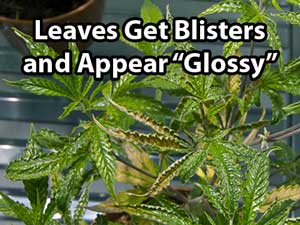Of all the mite species that are pest to plants these two seem to give growers the most trouble. These mites for their size can deal out a lot of damage to a crop/plant and because of their size they are hard to spot early enough to prevent damage.
Broad mites have 4 life’s sages from egg to adult, where russet mites have two nymph stages. Both mites have a life cycle that is around 8-15 days longs based on environmental conditions. The hotter the environment the faster they breed and die. They are capable of laying 5 eggs a day which can be identified by their unique characteristics. Broad mite eggs are translucent and colorless and are elliptical in shape. Russet mite eggs are clear and round.
Broad Mites
A Broad mite like the russet mite is very small and under a 60X microscope. Under scope they will appear oval in shape and can be green yellow or amber with a median strip that forks near the back of the body.
Broad mite damage is caused by draining the plant of its nutrients and will make leaves coppery or purplish. Because of the toxicity of their saliva the damage will cause terminal leaves and buds to be deformed, shorten internode lengthening. Overall plant health will suffer and growth won’t be optimal.
Russet Mites
Russet can be identified by its wedge shape and only having two front legs. As adults they appear to be yellow and are conical in shape. Russet mite infestations will always progress up a plant leaving lower leaves and stems drained that has a bronzed and will have a greasy appearance.
Russet mite infestations do not web up plants when they become large making them hard to identify unless seen under a scope. A 60X scope is more then enough to spot this invasive pest. The “tacoing effect “of leaves and bronzing can appear as a nutrient or dry down issue and will affect the entire plant when populations become large enough. The damage caused by this pest will have a severe effect on growth and bud/fruit production. Noticing the signs early and consistently checking your crop as preventative care is important.
Controls for Russet and Broad mites
Prevention is key to keeping these pests out of your crop. Maintain a clean growing environment, change your clothes on entering yours or others grow environments. Once a population has been discovered your options for control and eradication are limited by environment and safe standards and practices.
Treating an infestation can be as simple as applying a variety of products on a cycle that disrupts their breeding/life cycle. Pyrethrin’s are a great contact killer but are a neurotoxin and must be used ethically. Insecticidal soaps make for great spot treatments but can only be used when no buds or fruit are present. Oils and botanicals like neem or hypanthium or capsicum can have great response when used properly. A lot of the effectiveness of any of these treatments depends on percentage of contact with populations and their effects on various life stages. A product with residual effects like Bio-Insecticides have a slower but consecutive action to take down these pests. Products containing Isaria furmosorosea or chromobacterium will be eco friendly options as well as safe options for plants in both early flowering and vegetative stage of production.
Another option, one that is being seen more and more as the better option is using Beneficial Biologicals to combat the pest that predate on your pest and act as your first line of defense against plant pest..Beneficial predatory mites like Amblyseius Californicus and Amblyseius Swrisksi will both eat eggs and all life stages of mites they prey on. Tailoring your predatory mite choice to your unique environment, temps/relative humidity will help create an optimal environment for your beneficial bugs and keep the pest at bay and your Beneficial’s happy.
Continued applications of products and/or beneficial insects must be done in intervals that interrupt breeding, growth and birth cycles of your target pest. As a rule of thumb, with heavy infestations, contact killing applications should be applied every 1-3 days. Ingestible poisons or beneficial bacteria/fungi 2-4 day intervals. Any sort of soaps or botanical oils should be applied 3-6 day intervals. As your population density becomes manageable you change your application intervals as necessary. Switching between different chemical and biological controls requires planning some of your chemical products can affect your biologicals. Planning out a treatment plan using different products with different modes of action will boost your chances of control significantly.



